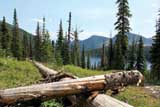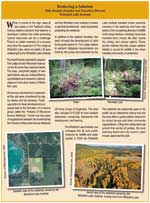Development and Roads
Development continues in the Flathead Watershed as more people and businesses locate here. Much of the new residential development is taking place outside of city limits in areas converted from agricultural land or forests. Land development and related activities can adversely impact water quality in the watershed. It can also put stress on our native wildlife populations when land that was once wildlife habitat is lost to development.
Like humans, all plants and animals require certain habitats to survive. The conversion of natural landscapes into developed landscapes results in habitat loss. This reduction or elimination of space and vegetation can lead to displacement of wildlife, from which some species may not survive. Another effect of development is habitat fragmentation, when large portions of natural landscape are subdivided and developed, leaving a mosaic of small patches of habitat insufficient to support wildlife.
Fragmented habitats decrease species’ abilities to reproduce and withstand environmental stresses, therefore decreasing their potential to survive. Human encroachment into natural areas also creates edge effects - abrupt boundaries between developed and natural habitat. These edges create dramatic changes in habitat that decrease the ability for many species to survive. Thoughtful planning helps reduce these impacts to our water quality, wildlife, and quality of life.
Low Impact Development (LID) is an ecologically-sensitive design trend in land development that mimics the way natural areas store and move rainwater. This protects water quality by decentralizing stormwater management and absorbing rainfall through the landscape. It minimizes impervious surfaces (such as roads, driveways, and roofs) and mitigates the effects of necessary impervious surfaces. Wetlands, woodlands, vegetated stream buffers, and natural drainage patterns are maintained, protecting wildlife habitat and biodiversity, in addition to water quality. Keeping water on site reduces pollutant loads, moderates peak stream flow rates, and enhances base flows.
 |
| Figure 5.7: The LID Approach to Storm Water Management. Source: Doug Adamson/Natural Resources Conservation Service |
LID benefits homeowners by:
- increasing community character
- improving quality of life
- increasing open space
- promoting pedestrian-friendly landscaping
LID benefits developers by:
- reducing land clearing and grading costs
- reducing infrastructure costs (streets, curbs, gutters, sidewalks), and
- increasing lot values and community marketability
LID benefits the environment by:
- protecting environmentally-sensitive areas
- preserving wildlife habitat
- reducing pollutant loads
- reducing stream bank and channel erosion by reducing peak flows and moderating the frequent “bounce” associated with lower intensity storms
- decreasing flooding
Cluster Development (CD) is also used in some areas as a means of permanently protecting open space, environmental resources, and rural character. CD groups residential structures in clusters while reserving and protecting significant open space. The open space can be used by residents through trails and passive recreation areas, for preservation of agricultural land, or for protection of wildlife habitat. Cluster Development allows land owners and developers to build the same number of housing units on a given parcel, while leaving a larger amount undeveloped. This reduces the financial burden of protecting open space and offers numerous opportunities for protecting land and water resources.
Roads and driveways move people between destinations, but they also move runoff into our waterways. As vehicles travel our dirt and gravel roadways, they compact the soil, reducing its absorbency. Compacted dirt roads and paved roads send polluted water and sediments across the ground eventually ending up in our waterways. Roads also provide transport of invasive weeds to land/water interfaces where they become established, often outcompeting native plants. The root systems of weeds are generally not as stabilizing as those of native plants, so their presence can destabilize the soil along riverbanks and lakeshores eventually leading to erosion.
There are a number of actions that can be taken to reduce the impact of roads:
- Design and build roads and driveways with proper drainage and culverts to handle runoff.
- Design U-shaped ditches for runoff diversions.
- Avoid removing vegetation along roads and ditches.
- Plant buffer strips of vegetation along roads and ditches to intercept runoff.
- Divert water flow into flat areas where sediments can be naturally filtered out.
- Keep roads and driveway lengths and widths to a minimum to reduce water velocity.
Roads and human development can disturb the watershed’s ecological integrity, and fragment important wildlife habitat and migration corridors. Our transportation routes and connecting roads tend to break ecosystems into smaller island-like areas. This fragmentation blocks important movement of wildlife for food, shelter, reproduction and seasonal refuge. Planning that takes wildlife into account will help us keep our wildlife safe and healthy, and help prevent costly and sometimes deadly accidents between drivers and wildlife.
Some projects in the Flathead Watershed address the importance of protecting our resources and waterways while making room for development, such as the wildlife crossings installed on U.S. Highway 93.
| Resources for Low Impact Development | |
| Center for Watershed Protection http://www.cwp.org 410.461.8323 |
Low Impact Development http://www.lowimactdevelopment.org 301.982.5559 |
| Flathead Conservation District http://www.flatheadcd.org 406.752.4220 |
Montana DNRC http://dnrc.mt.gov Kalispell: 406.751.2240 Polson: 406.883.3960 |
| Flathead County Planning http://www.flathead.mt.gov/planning_zoning 406.751.8200 |
National Stormwater Center http://www.stormwatercenter.org 888.288.6852 |
| Flathead Green Building Association http://www.fbagreen.com |
Natural Resources Conservation Services (NRCS) http://www.mt.nrcs.usda.gov 406.587.6811 Low Impact Development |
| Lake County Planning Department http://www.lakecounty-mt.org 406.883.7235 |
U.S. Environmental Protection Agency http://www.epa.gov/owow/nps/lid 800.227.8917 |
Homeowners and developers play an important role in the protection of watershed health through thoughtful landscaping practices. Landscaping with native and drought tolerant plants saves time, money, and water. It saves time because native plants need little long-term maintenance after plantings are established. It saves money because they need fewer, if any fertilizers or pesticides. It saves water because they are accustomed to our hot, dry summers. Avoid using chemicals such as fertilizers, herbicides, and insecticides near water bodies, and when used, be sure to apply such products properly to keep excess from running into streams, harming wildlife and contaminating our drinking water. Here are some tips:
- Test soil first to identify nutrient deficiencies before applying any fertilizers.
- Apply chemical products sparingly; extra product does not mean extra benefit.
- Do not apply chemicals before a heavy rainfall unless specified on the label.
- Use caution on slopes so that fertilizer doesn’t run into storm drains or waterways.
Consider natural lawn chemical alternatives. - Consider composting for a natural, slow release fertilizer and soil enhancer.
- Properly dispose of pet waste.
| Resources for Landscaping |
| Montana Native Plant Society http://www.mtnativeplants.org |
| Montana Natural Heritage Program http://mtnhp.org 406.444.5354 |
| Montana Nursery & Landscape Association http://www.plantingmontana.com 888.220.1569 Native Plants in MT/Drought Tolerant Plants & Xeriscaping in MT |



